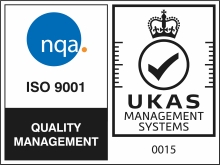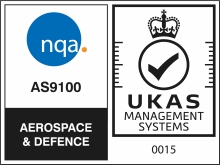Surface Roughness
Surface roughness, often shortened to roughness, is a measure of the texture of a surface. It is quantified by the vertical deviations of a real surface from its ideal form. If these deviations are large, the surface is rough; if they are small the surface is smooth. Roughness is typically considered to be the high frequency, short wavelength component of a measured surface .
Roughness plays an important role in determining how a real object will interact with its environment. Rough surfaces usually wear more quickly and have higher friction coefficients than smooth surfaces. Roughness is often a good predictor of the performance of a mechanical component, since irregularities in the surface may form nucleation sites for cracks or corrosion. On the other hand, roughness may promote adhesion.
Although roughness is often undesirable, it is difficult and expensive to control in manufacturing. Decreasing the roughness of a surface will usually increase exponentially its manufacturing costs. This often results in a trade-off between the manufacturing cost of a component and its performance in application.
Roughness is typically measured in "RMS" microinches and is often only measured by manual comparison against a "surface roughness comparator", a sample of known surface roughnesses.
Roughness is typically measured in "RMS" microinches and is often only measured by manual comparison against a "surface roughness comparator", a sample of known surface roughnesses.
|
RA is the arithmetic average deviation of the surface valleys and peaks and is often used to specify the roughness of a machined surface. RMS is the root mean square average of the profile height deviations from the mean line of the surface and is mostly used for optical surfaces. |
|||||||||||||
| The term Micro means millionth. So 1 micrometer is 1 millionth of a meter, or .000001 meter. Likewise 1 microinch is 1 millionth of an inch, or .000001". The term "Micron" refers to 1 millionth of a meter, which is also equivalent to 1 thousanth of a millimeter (.001 mm), and is represented by the greek symbol μ. Ra microinch ( μ" ) is basically the same as the CLA scale, or centerline average. | |||||||||||||
| ABREVIATIONS | UNIT CONVERSIONS | ||||||||||||
| Inch = " or in | 1 microinch (μ") = 0.0254 micrometers (or microns) | ||||||||||||
| Micron = µ | 1 microinch (μ") = 0.0000254mm | ||||||||||||
| Micro Inch = µ" | 0.001" = 0.0254mm | ||||||||||||
| Micrometer = µm | |||||||||||||
| Millimeter = mm | |||||||||||||
| Below are equivalent values on various surface measurment scales, and the manufacturing methods capable of producing these finishes. | |||||||||||||
| New ISO scale numbers | 1. | 2. | 3. | 4. | 5. | 6. | 7. | 8. | 9. | 10. | 11. | 12. | |
| RMS Microinches ( μ" ) | 0.5 | 1.1 | 2.2 | 4.4 | 8.8 | 17.6 | 35.2 | 64.3 | 137.5 | 275 | 550 | 1100 | 2200 |
| RMS Micrometers ( μ m ) | 0.013 | 0.027 | 0.055 | 0.11 | 0.22 | .44 | .88 | 1.6 | 3.44 | 6.88 | 13.75 | 27.5 | 55 |
| CLA or Ra microinch ( μ" ) | 0.5 | 1 | 2 | 4 | 8 | 16 | 32 | 63 | 125 | 250 | 500 | 1000 | 2000 |
| Ra micrometer ( μ m ) | 0.012 | 0.03 | 0.05 | 0.1 | 0.2 | 0.4 | 0.8 | 1.6 | 3.2 | 6.3 | 12.5 | 25 | 50 |
Surface Roughness Table - Shows the roughness average for different manufacturing processes in micrometers and microinches. The values are shown with a typical range and a less frequent range for each manufacturing process.
| Average Range | |
| Less Frequent Range |
| Manufacturing Process | Roughness Average Top Number - Micrometers Bottom Number - (Microinches) |
|||||||||||||||||||||||||
| 50 (2000) | 25 (1000) | 12.5 (500) | 6.3 (250) | 3.2 (125) | 1.6 (63) | 0.80 (32) | 0.40 (16) | 0.20 (8) | 0.10 (4) | 0.05 (2) | 0.025 (1) | 0.012 (.5) | ||||||||||||||
| Flame Cutting | ||||||||||||||||||||||||||
| Snagging | ||||||||||||||||||||||||||
| Sawing | ||||||||||||||||||||||||||
| Planing, Shaping | ||||||||||||||||||||||||||
| Drilling | ||||||||||||||||||||||||||
| Chemical Milling | ||||||||||||||||||||||||||
| Elect Discharge Machining | ||||||||||||||||||||||||||
| Milling | ||||||||||||||||||||||||||
| Broaching | ||||||||||||||||||||||||||
| Reaming | ||||||||||||||||||||||||||
| Electron Beam | ||||||||||||||||||||||||||
| Laser | ||||||||||||||||||||||||||
| Electro-Chemical | ||||||||||||||||||||||||||
| Boring, Turning | ||||||||||||||||||||||||||
| Barrel Finishing | ||||||||||||||||||||||||||
| 50 (2000) | 25 (1000) | 12.5 (500) | 6.3 (250) | 3.2 (125) | 1.6 (63) | 0.80 (32) | 0.40 (16) | 0.20 (8) | 0.10 (4) | 0.05 (2) | 0.025 (1) | 0.012 (.5) | ||||||||||||||
| Electrolytic Grinding | ||||||||||||||||||||||||||
| Roller Burnishing | ||||||||||||||||||||||||||
| Grinding | ||||||||||||||||||||||||||
| Honing | ||||||||||||||||||||||||||
| Electro-Polish | ||||||||||||||||||||||||||
| Polishing | ||||||||||||||||||||||||||
| Lapping | ||||||||||||||||||||||||||
| Super Finishing | ||||||||||||||||||||||||||
| Sand Casting | ||||||||||||||||||||||||||
| Hot Rolling | ||||||||||||||||||||||||||
| Forging | ||||||||||||||||||||||||||
| Permanent Mold Casting | ||||||||||||||||||||||||||
| Investment Casting | ||||||||||||||||||||||||||
| Extruding | ||||||||||||||||||||||||||
| Cold Rolling, Drawing | ||||||||||||||||||||||||||
| Die Casting | ||||||||||||||||||||||||||
| 50 (2000) | 25 (1000) | 12.5 (500) | 6.3 (250) | 3.2 (125) | 1.6 (63) | 0.80 (32) | 0.40 (16) | 0.20 (8) | 0.10 (4) | 0.05 (2) | 0.025 (1) | 0.012 (.5) | ||||||||||||||


